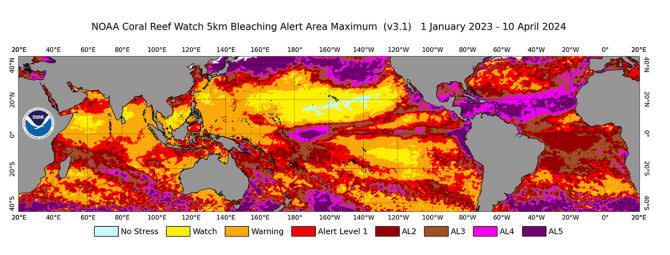A Global Coral Bleaching Event Has Officially Been Confirmed

It’s official: we’re in the midst of yet another global coral bleaching event. It’s the fourth on record and the second in the last 10 years.
“From February 2023 to April 2024,” said Dr. Derek Manzello in a statement released on April 15 by the National Oceanic and Atmospheric Administration (NOAA), “significant coral bleaching has been documented in both the Northern and Southern Hemispheres of each major ocean basin.”
When corals are stressed, they spit out the algae that lives in their tissues. That algae lives symbiotically with the corals, and is of vital importance to the ecosystem. Temperature, light, drastic changes in nutrients can all cause coral bleaching. When the algae is expelled the corals turn white, which is where the term “bleaching” comes from.
It’s not necessarily a death sentence, though, and does happen quite often, but when it goes on for too long, the corals can die. And in recent years, those bleaching events have been happening more frequently and lasting longer. This is largely due, as you might’ve expected, to our warming seas.
In one particularly devastating event in 2005, the U.S. lost nearly half of the reefs in the Caribbean in a single year. The ocean near Puerto Rico warmed dramatically and spread that warmth farther than usual. According to IFL Science, “Comparison of satellite data from the previous 20 years confirmed that thermal stress from the 2005 event was greater than the previous 20 years combined.”
Since then, mass bleaching events have continued in much of the tropics, ranging from Florida and the Caribbean to Brazil, the Red Sea, and perhaps most notably, Australia’s Great Barrier Reef. With the record-breaking average global temperatures we’ve been seeing recently, it’s not much of a surprise that coral reefs around the world are in dire straits.

“As the world’s oceans continue to warm, coral bleaching is becoming more frequent and severe,” Dr. Manzello explained. “When these events are sufficiently severe or prolonged, they can cause coral mortality, which hurts the people who depend on the coral reefs for their livelihoods.”
The NOAA has been keeping a close eye on bleaching events for decades now, so they have plenty of data to look back on. The first global bleaching event on record happened in 1998, followed by progressively worse ones in 2010 and 2014 through 2017.
Manzello said in his statement that over half — 54 percent, to be exact — of the coral reefs around the world have been under enough heat-related stress to bleach in the last year alone. He told the New York Times that “this event is likely to be the most spatially extensive global bleaching event on record.”
Coral can, however, recover, as long as the cause behind it halts. Scientists have been undertaking a variety of different efforts to help, including moving entire coral nurseries to deeper water, where the warming hasn’t reached. Sunshades have also been erected in certain areas in an attempt to keep the brunt of the sun off them, but water, as you know, tends to move around, and the warm waters outside the shade mix in with the cooler parts.
With NOAA’s latest announcement, it’s clear that not enough is being done to solve a problem we’ve created.
The post A Global Coral Bleaching Event Has Officially Been Confirmed first appeared on The Inertia.

